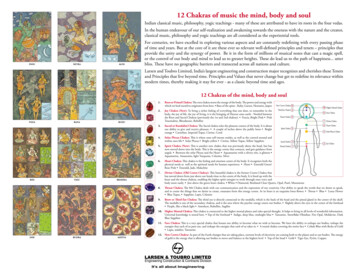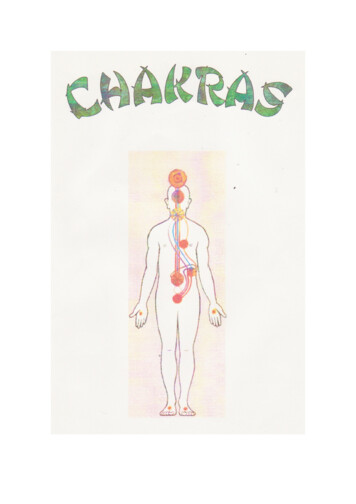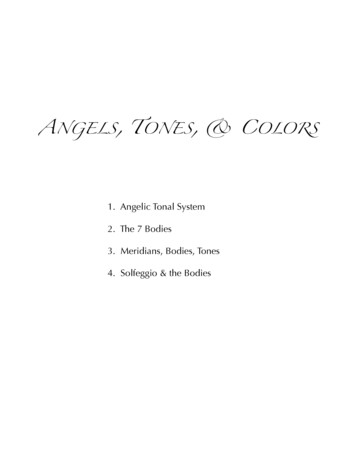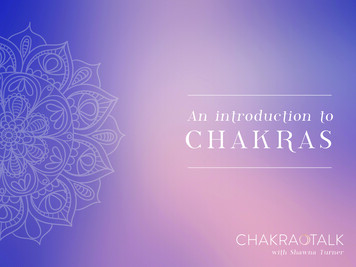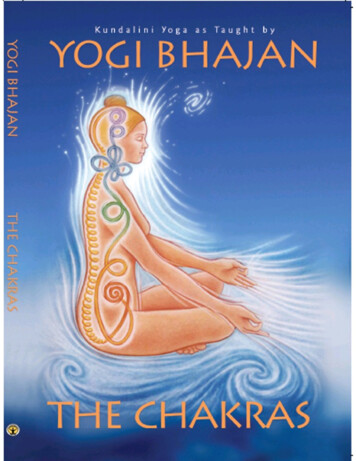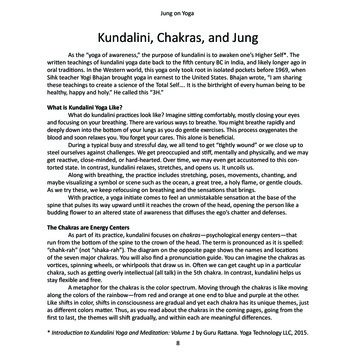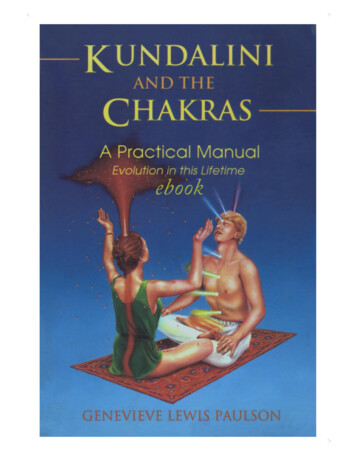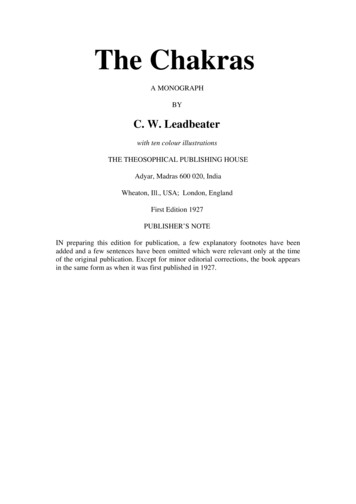
Transcription
The ChakrasA MONOGRAPHBYC. W. Leadbeaterwith ten colour illustrationsTHE THEOSOPHICAL PUBLISHING HOUSEAdyar, Madras 600 020, IndiaWheaton, Ill., USA; London, EnglandFirst Edition 1927PUBLISHER’S NOTEIN preparing this edition for publication, a few explanatory footnotes have beenadded and a few sentences have been omitted which were relevant only at the timeof the original publication. Except for minor editorial corrections, the book appearsin the same form as when it was first published in 1927.
PREFACE TO THE FIRST EDITIONWHEN a man begins to develop his senses, so that he may see a little more thaneverybody sees, a new and most fascinating world opens before him, and the chakrasare among the first objects in that world to attract his attention. His fellow-menpresent themselves under a fresh aspect; he perceives much with regard to themwhich was previously hidden from his eyes, and he is therefore able to understand,to appreciate and (when necessary) to help them much better than he could before.Their thoughts and feelings are expressed clearly before his eyes in colour and form;the stage of their development, the condition of their health become obvious factsinstead of mere matters of inference. The brilliant colouring and the rapid andincessant movement of the chakras bring them immediately under his observation,and he naturally wants to know what they are and what they mean. It is the object ofthis book to provide an answer to those questions and to give to those who have notyet made any attempt to unfold their dormant faculties some idea of at least this onesmall section of what is seen by their more fortunate brethren.In order to clear away inevitable preliminary misconceptions, let it be definitelyunderstood that there is nothing fanciful or unnatural about the sight which enablessome men to perceive more than others. It is simply an extension of faculties withwhich we are all familiar, and to acquire it is to make oneself sensitive to vibrationsmore rapid than those to which our physical senses are normally trained to respond.These faculties will come to everyone in due course of evolution, but some of ushave taken special trouble to develop them now in advance of the rest, at the cost ofmany years of harder work than most people would care to undertake.I know that there are still many men in the world who are so far behind the times asto deny the existence of such powers, just as there are still villagers who have neverseen a railway train. I have neither time nor space to argue with such invincible ignorance; I can only refer enquirers to my book on Clairvoyance, or to scores ofbooks by other authors on the same subject. The whole case has been provedhundreds of times, and no one who is capable of weighing the value of evidence canany longer be in doubt.Much has been written about the chakras, but it is chiefly in Sanskrit or in some ofthe Indian vernaculars. It is only quite recently that any account of them has appeared in English. I mentioned them myself in The Inner Life about 1910, and since then Sir John Woodroffe’s magnificent work The Serpent Power has beenissued, and some of the other Indian books have been translated. The symbolicaldrawings of them which are used by the Indian yogis were reproduced in TheSerpent Power, but so far as I am aware the illustrations which I give in this bookare the first attempt to represent them as they actually appear to those who can seethem. Indeed, it is chiefly in order to put before the public this fine series ofdrawings by my friend the Rev. Edward Warner that I write this book, and I wish toexpress my deep indebtedness to him for all the time and trouble that he has devotedto them. I have also to thank my indefatigable collaborator, Professor Ernest Wood,2
for the collection and collation of all the valuable information as to the Indian viewson our subject which is contained in Chapter V.Being much occupied with other work, it was my intention merely to collect andreprint as accompanying letterpress to the illustrations the various articles which Ihad long ago written on the subject; but as I looked over them certain questionssuggested themselves and a little investigation put me in possession of additionalfacts, which I have duly incorporated. An interesting point is that both the vitalityglobule and the kundalini-ring were observed by Dr. Annie Besant and cataloguedas hyper-meta-proto elements as long ago as 1895, though we did not then followthem far enough to discover their relation to one another and the important part thatthey play in the economy of human life.C. W. L.3
CONTENTSPREFACECHAPTER ITHE FORCE-CENTRESThe Meaning of the Word. Preliminary Explanations. The EthericDouble. The Centres. The Forms of the Vortices. The Illustrations.The Root Chakra. The Spleen Chakra. The Navel Chakra. The HeartChakra. The Throat Chakra. The Brow Chakra. The Crown Chakra.Other Accounts of the Centres.CHAPTER IITHE FORCESThe Primary or Life Force. The Serpent-Fire. The Three SpinalChannels. The Marriage of the Forces. The Sympathetic System. TheCentres in the Spine. Vitality. The Vitality Globule. The Supply ofGlobules. Psychic Forces.CHAPTER IIITHE ABSORPTION OF VITALITYThe Globule. The Violet-Blue Ray. The Yellow Ray: The GreenRay. The Rose Ray. The Orange-Red Ray. The Five Prana Vayus.Vitality and Health. The Fate of the Empty Atoms. Vitality andMagnetism.CHAPTER IVTHE DEVELOPMENT OF THE CHAKRASThe Functions of the Awakened Centres. The Astral Centres. AstralSenses. The Arousing of Kundalini. The Awakening of the EthericChakras. Casual Clairvoyance. The Danger of PrematureAwakening. The Spontaneous Awakening of Kundalini. PersonalExperience. The Etheric Web. The Effects of Alcohol and Drugs.The Effect of Tobacco. The Opening of the Doors.CHAPTER VTHE LAYA YOGAThe Hindu Books. The Indian List of Chakras. The Figures of theChakras. The Heart Chakra. The Petals and Letters. The Mandalas.The Yantras. The Animals. The Divinities. The Body Meditation.The Knots. The Secondary Heart Lotus. Effects of Meditation in theHeart. Kundalini. The Awakening of Kundalini. The Ascent ofKundalini. The Goal of Kundalini. Conclusion.4
CHAPTER ITHE FORCE - CENTRESTHE MEANING OF THE WORD1.2.3.4.5.THE word Chakra is Sanskrit, and signifies a wheel. It is alsoused in various subsidiary, derivative and symbolical senses, just as is itsEnglish equivalent; as we might speak of the wheel of fate, so does theBuddhist speak of the wheel of life and death; and he describes that firstgreat sermon in which the Lord Buddha propounded his doctrine as theDhammachakkappavattana Sutta (chakka being the Pali equivalent for theSanskrit chakra) which Professor Rhys Davids poetically renders as “toset rolling the royal chariot-wheel of a universal empire of truth andrighteousness”. That is exactly the spirit of the meaning which theexpression conveys to the Buddhist devotee, though the literal translationof the bare words is “the turning of the wheel of the Law”. The special useof the word chakra with which we are at the moment concerned is itsapplication to a series of wheel-like vortices which exist in the surface ofthe etheric double of man.PRELIMINARY EXPLANATIONSAs this hook may probably fall into the hands of some who arenot familiar with Theosophical terminology it may be well to insert here afew words of preliminary explanation.In ordinary superficial conversation a man sometimesmentions his soul - implying that the body through which he speaks is thereal man, and that this thing called the soul is a possession or appanage ofthat body - a sort of captive balloon floating over him, and in some vaguesort of way attached to him. This is a loose, inaccurate and misleadingstatement; the exact opposite is the truth. Man is a soul and owns a body several bodies in fact; for besides the visible vehicle by means of which hetransacts his business with his lower world, he has others which are notvisible to ordinary sight, by means of which he deals with the emotionaland mental worlds. With those, however, we are not for the momentconcerned.In the course of the last century enormous advances have beenmade in our knowledge of the minute details of the physical body;students of medicine are now familiar with its bewildering complexities,and have at least a general idea of the way in which its amazingly intricatemachinery works.5
6.7.THE ETHERIC DOUBLENaturally, however, they have had to confine their attention tothat part of the body which is dense enough to be visible to the eye, andmost of them are probably unaware of the existence of that type of matter,still physical though invisible, to which in Theosophy we give the name of[*]etheric.This invisible part of the physical body is of great importanceto us, for it is the vehicle through which flow the streams of vitality whichkeep the body alive, and without it as a bridge to convey undulations ofthought and feeling from the astral to the visible denser physical matter,[†]8.9.the ego- could make no use of the cells of his brain. It is clearly visibleto the clairvoyant as a mass of faintly-luminous violet-grey mist,interpenetrating the denser part of the body, and extending very slightlybeyond it.The life of the physical body is one of perpetual change, and inorder that it shall live it needs constantly to be supplied from three distinctsources. It must have food for its digestion, air for its breathing, andvitality in three forms for its absorption. This vitality is essentially a force,but when clothed with matter it appears to us as though it were a highlyrefined chemical element. It exists upon all planes, but our business for themoment is to consider its manifestation in the physical world.In order to understand that, we must know something of theconstitution and arrangement of this etheric part of our bodies. I havewritten on this subject many years ago in various volumes, and Colonel A.E. Powell has recently gathered together all the information heretofore published and issued it in a convenient form in a book called The Etheric[‡]Double.10.11.THE CENTRESThe chakras or force-centres are points of connection at whichenergy flows from one vehicle or body of a man to another. Anyone whopossesses a slight degree of clairvoyance may easily see them in theetheric double, where they show themselves as saucer-like depressions orvortices in its surface. When quite undeveloped they appear as smallcircles about two inches in diameter, glowing dully in the ordinary man;but when awakened and vivified they are seen as blazing, coruscatingwhirlpools, much increased in size, and resembling miniature suns. Wesometimes speak of them as roughly corresponding to certain physicalorgans; in reality they show themselves at the surface of the ethericdouble, which projects slightly beyond the outline of the dense body. If we6
12.13.imagine ourselves to be looking straight down into the bell of a flower ofthe convolvulus type, we shall get some idea of the general appearance ofa chakra. The stalk of the flower in each springs from a point in the spine,so another view might show the spine as a central stem (see Plate VIII),from which flowers shoot forth at intervals, showing the opening of theirbells at the surface of the etheric body.The seven centres with which we are at present concerned areindicated in the accompanying illustration (Fig. 1). Table I gives theirEnglish and Sanskrit names.All these wheels are perpetually rotating, and into the hub oropen mouth of each a force from the higher world is always flowing- amanifestation of the life-stream issuing from the Second Aspect of theSolar Logos - which we call the primary force. That force is sevenfold inits nature, and all its forms operate in each of these centres, although oneof them in each case usually predominates over the others. Without thisinrush of energy the physical body could not exist. Therefore the centresare in operation in every one, although in the undeveloped person they areusually in comparatively sluggish motion, just forming the necessaryvortex for the force, and no more. In a more evolved man they may beglowing and pulsating with living light, so that an enormously greateramount of energy passes through them, with the result that there areadditional faculties and possibilities open to the man.15.16.THE FORM OF THE VORTICESThis divine energy which pours into each centre from withoutsets up at right angles to itself (that is to say, in the surface of the ethericdouble) secondary forces in undulatory circular motion, just as bar-magnetthrust into an induction coil produces a current of electricity which flowsround the coil at right angles to the axis or direction of the magnet. Theprimary force itself, having entered the vortex, radiates from it again atright angles, but in straight lines, as though the centre of the vortex werethe hub of a wheel, and the radiations of the primary force its spokes. Bymeans of these spokes the force seems to bind the astral and etheric bodiestogether as though with grappling-hooks. The number of these spokesdiffers in the different force-centres, and determines the number of wavesor petals which each of them exhibits. Because of this these centres haveoften been poetically described in Oriental books as resembling flowers.English NameRootorBasicSanskritNameMuladharaSituationAt the base of the7
ChakraSpleen or SplenicChakraNavelorUmbilical ChakraHeart or CardiacChakraThroatorLaryngeal ChakraBrow or frontalChakraCrownorCoronal Chakra17.18.19. ManipuraAnahataVishuddhaAjnaSahasraraspineOver the spleenAt the navel, overthe solar plexusOver the heartAt the front of thethroatIn the spacebetween the eyebrowsOn the top of theheadTABLE 1Each of the secondary forces which sweep round the saucerlike depression has its own characteristic wave-length, just as has light ofa certain colour; but instead of moving in a straight line as light does, itmoves along relatively large undulations of various sizes, each of which issome multiple of the smaller wave-lengths within it. The number ofundulations is determined by the number of spokes in the wheel, and thesecondary force weaves itself under and over the radiating currents of theprimary force, just as basket-work might be woven round the spokes of acarriage-wheel. The wave-lengths are infinitesimal, and probablythousands of them are included within one of the undulations. As theforces rush round in the vortex, these oscillations of different sizes,crossing one another in this basket-work fashion, produce the flower-likeform to which I have referred. It is, perhaps, still more like the appearanceof certain saucers or shallow vases of wavy iridescent glass, such as aremade in Venice. All of these undulations or petals have that shimmeringpavonine effect, like mother-of-pearl, yet each of them has usually its ownpredominant colour, as will be seen from our illustrations. This nacreoussilvery aspect is likened in Sanskrit works to the gleam of moonlight onwater.THE ILLUSTRATIONS8
20.21.22.23.24.These illustrations of ours show the chakras as seen byclairvoyant sight in a fairly evolved and intelligent person, who hasalready brought them to some extent into working order. Of course ourcolours are not sufficiently luminous - no earthly colours could be; but atleast the drawings will give some idea of the actual appearance of thesewheels of light. It will be understood from what has already been said thatthe centres vary in size and in brightness in different people, and that evenin the same person some of them may be much more developed than therest. They are drawn about life-size, except for the Sahasrara or crownchakra, which we have found it necessary to magnify in order to show itsamazing wealth of detail. In the case of a man who excels greatly in thequalities which express themselves through a certain centre, that centrewill be not only much enlarged but also especially radiant, throwing outbrilliant golden rays. An example of that may be seen in MadameBlavatsky’s precipitation of the aura of Mr. Stainton Moses, which is nowkept in a cabinet in the archives of the Society at Adyar. It is reproduced,though very imperfectly, on page 364 of Volume I of Colonel Olcott’s OldDiary Leaves.These chakras naturally divide into three groups, the lower, themiddle and the higher; they might be called respectively the physiological,the personal and the spiritual.The first and second chakras, having but few spokes or petals,are principally concerned with receiving into the body two forces whichcome into it at that physical level - one being the serpent-fire from theearth and the other the vitality from the sun. The centres of the middlegroup, numbered 3, 4 and 5, are engaged with the forces which reach manthrough his personality - through the lower astral in the case of centre 3,the higher astral in centre 4, and from the lower mind in centre 5. All thesecentres seem to feed certain ganglia in the body. Centres 6 and 7 standapart from the rest, being connected with the pituitary body and the pinealgland respectively, and coming into action only when a certain amount ofspiritual development has taken place.I have heard it suggested that each of the different petals ofthese force-centres represents a moral quality, and that the development ofthat quality brings the centre into activity. For example, in The Dhyanabindu Upanishad the petals of the heart chakra are associated withdevotion, laziness, anger, charity and similar qualities. I have not yet metwith any facts which definitely confirm this, and it is not easy to seeexactly how it can be, because the appearance is produced by certainreadily recognizable forces, and the petals in any particular centre areeither active or not active according as these forces have or have not beenaroused, and their unfoldment seems to have no more direct connectionwith morality than has the enlargement of the biceps. I have certainly metwith persons in whom some of the centres were in full activity, though themoral advancement was by no means exceptionally high, whereas in otherpersons of high spirituality and the noblest possible morality the centreswere scarcely yet vitalized at all; so that there does not seem to be anynecessary connection between the two developments.There are, however, certain facts observable which may be thebasis of this rather curious idea. Although the likeness to petals is causedby the same forces flowing round and round the centre, alternately over9
and under the various spokes, those spokes differ in character, because theinrushing force is subdivided into its component parts or qualities, andtherefore each spoke radiates a specialized influence of its own, eventhough the variations be slight. The secondary force, in passing eachspoke, is to some extent modified by its influence, and therefore changes alittle in its hue. Some of these shades of colour may indicate a form of theforce which is helpful to the growth of some moral quality, and when thatquality is strengthened its corresponding vibration will be more pronounced. Thus the deepening or weakening of the tint might be taken tobetoken the possession of more or less of that attribute.25.26.27.28.29.THE ROOT CHAKRAThe first centre, the basic (Plate I), at the base of the spine, hasa primary force which radiates out in four spokes, and therefore arrangesits undulations so as to give the effect of its being divided into quadrants,alternately red and orange in hue, with hollows between them. This makesit seem as though marked with the sign of the cross, and for that reason thecross is often used to symbolize this centre, and sometimes a flaming crossis taken to indicate the serpent-fire which resides in it. When acting withany vigour this chakra is fiery orange-red in colour, corresponding closelywith the type of vitality which is sent down to it from the splenic centre.Indeed, it will be noticed that in the case of every one of the chakras asimilar correspondence with the colour of its vitality may be seen.THE SPLEEN CHAKRAThe second centre, the splenic (Plate II), at the spleen, isdevoted to the specialization, subdivision and dispersion of the vitalitywhich comes to us from the sun. That vitality is poured out again from itin six horizontal streams, the seventh variety being drawn into the hub ofthe wheel. This centre therefore has six petals or undulations, all ofdifferent colours, and is specially radiant, glowing and sunlike. Each of thesix divisions of the wheel shows predominantly the colour of one of theforms of the vital force -red, orange, yellow, green, blue and violet.THE NAVEL CHAKRA10
30.31.32.33.34.35.36.37.The third centre, the umbilical (Plate IV), at the navel or solarplexus, receives a primary force with ten radiations, so it vibrates in such amanner as to divide itself into ten undulations or petals. It is very closelyassociated with feelings and emotions of various kinds. Its predominantcolour is a curious blending of several shades of red, though there is also agreat deal of green in it. The divisions are alternately chiefly red andchiefly green.THE HEART CHAKRAThe fourth centre, the cardiac (Plate V), at the heart, is of aglowing golden colour, and each of its quadrants is divided into threeparts, which gives it twelve undulations, because its primary force makesfor it twelve spokes.THE THROAT CHAKRAThe fifth centre, the laryngeal (Plate VII), at the throat, hassixteen spokes, and therefore sixteen apparent divisions. There is a gooddeal of blue in it, but its general effect is silvery and gleaming, with a kindof suggestion as of moonlight upon rippling water. Blue and greenpredominate alternately in its sections.THE BROW CHAKRAThe sixth centre, the frontal (Plate IX), between the eyebrows,has the appearance of being divided into halves, one chiefly rose-coloured,though with a great deal of yellow about it, and the other predominantly akind of purplish-blue, again closely agreeing with the colours of thespecial types of vitality that vivify it. Perhaps it is for this reason that thiscentre is mentioned in Indian books as having only two petals, though ifwe are to count undulations of the same character as those of the previouscentres we shall find that each half is subdivided into forty-eight of these,making ninety-six in all, because its primary force has that number ofradiations.This sudden leap form 16 to 96 spokes, and again the evenmore startling variation from 96 to 972 between this and the next chakra,11
show us that we are now dealing with centres of an altogether differentorder from those which we have hitherto been considering. We do not yetknow all the factors which determine the number of spokes in a chakra,but it is already evident that they represent shades of variation in theprimary force. Before we can say much more than this, hundreds ofobservations and comparisons must be made - made, repeated and verifiedover and over again. But meantime this much is clear - that while the needof the personality can be satisfied by a limited number of types of force,when we come to the higher and more permanent principles of man weencounter a complexity, a multiplicity, which demands for its expression avastly greater selection of modifications of the energy.38.39.40.41.THE CROWN CHAKRAThe seventh centre, the coronal (see frontispiece), at the top ofthe head, is when stirred into full activity the most resplendent of all, fullof indescribable chromatic, effects and vibrating with almost inconceivable rapidity. It seems to contain all sorts of prismatic hues, but is onthe whole predominantly violet. It is described in Indian books asthousand-petalled, and really this is not very far from the truth, the numberof the radiations of its primary force in the outer circle being nine hundredand sixty. Every line of this will be seen faithfully reproduced in ourfrontispiece, though it is hardly possible to give the effect of the separatepetals. In addition to this it has a feature which is possessed by none of theother chakras - a sort of subsidiary central whirlpool of gleaming whiteflushed with gold in its heart - a minor activity which has twelveundulations of its own.This chakra is usually the last to be awakened. In thebeginning it is the same size as the others, but as the man progresses onthe Path of spiritual advancement it increases steadily until it coversalmost the whole top of the head. Another peculiarity attends itsdevelopment. It is at first a depression in the etheric body, as are all theother, because through it, as through them, the divine force flows in fromwithout; but when the man realizes his position as a king of the divinelight, dispensing largesse to all around him, this chakra reverses itself,turning as it were inside out; it is no longer a channel of reception but ofradiation, no longer a depression but a prominence, standing out from thehead as a dome, a veritable crown of glory.In Oriental pictures and statues of the deities or great men thisprominence is often shown. In Fig. 2 it appears on the head of a statue ofthe Lord Buddha at Borobudur in Java. This is the conventional method ofrepresenting it, and in this form it is to be found upon the heads ofthousands of images of the Lord Buddha all over the Eastern world. Inmany cases it will be seen that the two tiers of the Sahasrara chakra arecopied - the larger dome of 960 petals first, and then the smaller dome of12 rising out of that in turn. The head on the right is that of Brahma fromthe Hokke-do of Todai-ji, at Nara in Japan (dating from A.D. 749); and it12
will be seen that the statue is wearing a head-dress fashioned to representthis chakra, though in a form somewhat different from the last, showingthe coronet of flames shooting up from it.42.43.44.45.46.47.48.It appears also in the Christian symbology, in the crowns wornby the four-and-twenty elders who are for ever casting them down beforethe throne of God. In the highly developed man this coronal chakra poursout splendour and glory which makes for him a veritable crown; and themeaning of that passage of Scripture is that all that he has gained, all themagnificent karma that he makes, all the wondrous spiritual force that hegenerates - all that he casts perpetually at the feet of the Locos to be usedin his work. So, over and over again, can he continue to cast down hisgolden crown, because it continually re-forms as the force wells up fromwithin him.OTHER ACCOUNTS OF THE CENTRESThese seven force-centres are frequently described in Sanskritliterature, in some of the minor Upanishads, in the Puranas and in Tantricworks. They are used today by many Indian yogis. A friend acquaintedwith the inner life of India assures me that he knows of one school in thatcountry which makes free use of the chakras - a school which numbers asits pupils about sixteen thousand people scattered over a large area. Thereis much interesting information available on the subject from Hindusources, which we will try to summarize with comments in a later chapter.It appears also that certain European mystics were acquaintedwith the chakras. Evidence of this occurs in a book entitled TheosophiaPractica by the well-known German mystic Johann Georg Gichtel, a pupilof Jacob Boehme, who probably belonged to the secret society of theRosicrucians. It is from this work of Gichtel’s that our Plate III isreproduced by the kind permission of the publishers. This book wasoriginally issued in the year 1696, though in the edition of 1736 it is saidthat the pictures, of which the volume is mainly a description, were printedonly some ten years after the death of the author, which took place in1710. The book must be distinguished from a collection of Gichtel’scorrespondence put forth under the same title Theosophia Practica; thepresent volume is not in the form of letters, but consists of six chaptersdealing with the subject of that mystic regeneration which was such animportant tenet of the Rosicrucians.The illustration which we give here has been photographedfrom the French translation of the Theosophia Practica, published in 1897in the Bibliotheque Rosicrucienne (No. 4) by the Bibliotheque Chacornac,Paris.Gichtel, who was born in 1638, at Ratisbon in Bavaria, studiedtheology and law and practised as an advocate; but afterwards, becomingconscious of a spiritual world within, gave up all worldly interests andbecame the founder of a mystical Christian movement. Being opposed tothe ignorant orthodoxy of his time, he drew down upon himself the hatred13
49.50.51.52.53.70.of those whom he had attacked, and about 1670 he was consequentlybanished, and his property confiscated. He finally found refuge inHolland, where he lived for the remaining forty years of his life.He evidently considered the figures printed in his TheosophiaPractica as being of a secret nature; apparently they were kept within thesmall circle of his disciples for quite a number of years. They were, hesays, the result of an inner illumination - presumably of what in ourmodern times we should call clairvoyant faculties. On the title-page of hisbook he says that it is, “A short exposition of the three principles of thethree worlds in man, represented in clear pictures, showing how and wherethey have their respective Centres in the inner man; according to what theauthor has found in himself in divine contemplation, and what he has felt,tasted and perceived”.Like most mystics of his day, however, Gichtel lacks theexactitude which should characterize true occultism and mysticism; in hisdescription of the figures he allows himself lengthy, though oftentimesquite interesting digressions on the difficulties and problems of thespiritual life. As an exposition of his illustrations, however, his book is nota success. Perhaps he did not dare to say too much; or he may havewished to induce his readers to learn to see for thems
Chakras. Casual Clairvoyance. The Danger of Premature Awakening. The Spontaneous Awakening of Kundalini. Personal Experience. The Etheric Web. The Effects of Alcohol and Drugs. The Effect of Tobacco. The Opening of the Doors. CHAPTER V. THE LAYA YOGA: The Hindu Books. The Indian List of Chakr
